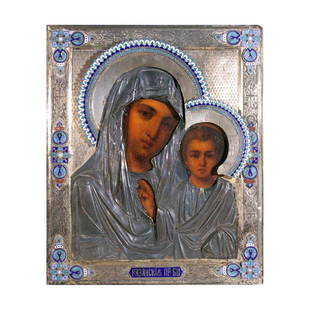
Our Lady of Kazan Antique Russian Icon 1908-1911 [173594]
Similar Sale History
Recommended Items





![Our Lady of Kazan Antique Russian Icon 1908-1911 [173594]](https://p1.liveauctioneers.com/2699/324080/174412930_1_x.jpg?quality=1&version=1711485545&width=486)
![Our Lady of Kazan Antique Russian Icon 1908-1911 [173594]](https://p1.liveauctioneers.com/2699/324080/174412930_1_x.jpg?quality=80&version=1711485545)
Item Details
Description
Beautiful Russian Icon of Our Lady of Kazan with three colors of gold plate over .875 silver oklad; rose gold (halo), yellow gold robes, veil and background and pale yellow or white gold undergarments. Large Greek letters "O" and "H" are engraved into the child's halo, meaning "Who Is", most commonly written with a preceding letter for "He Who Is", signifying Christ. This icon image is a variant of the "Odighitria'' type that depicts the child, Jesus, in an upright position. The engraving detail on the trim of the robes reflects light in a way that appears to sparkle, adding depth and appeal to the image. Verso is a rich orange velvet. Box measures approximately 7" x 5.75", in an 9" x 8" wood frame, seated inside a custom 10" x 9" x 2.5" light colored, wooden, glass top box with a brass latch and two metal hangars with leather cord mounted on reverse of box. There are a total of three Hallmarks on this piece; two on the front and one on the bottom edge.Hallmark #1. Located on the left side of the rose gold halo: The second Kokoshnik mark, used between 1908 and 1926, is an incuse oval with a woman's profile facing right in relief preceded by the Greek letter for Delta, which refers to Moscow as the region of assay, followed by the number 84. Underneath is a two letter maker's mark that appears to be an upside down stamp in an incuse square with the initials "CT" in relief in Latin letters. Hallmark # 2. Located on the bottom center on the front, on the sleeve of the robe. This mark is an incuse circle with only the woman's profile in relief facing right, with one dot to the left of the head in relief, which is morse code for the city (Moscow) followed by an incuse square with the letters "CT"in relief. This type of mark is known as a garniture mark, often used on small items or on auxiliary parts of an ensemble, indicating this icon was manufactured in separate pieces, though all three marks appear to be made by the same silversmith. Hallmark #3. Located on the bottom edge or "foot" has the same, second Kokoshnik mark as #1 above and the same maker's mark as #2. Purity of silver is .875, indicated by the 84 in hallmarks #1 and #3. (the number 84 indicates the obsolete Russian weight measure, zolotniki. 84 became the standard in 1798 and converts to .875) We were unable to identify a Russian silversmith with the initials CT. Our research is unclear as to the name of the Assayer, but some sources identify Fyodor Petrovich Konovalov, who worked between 1899 & 1911, which would put the date of manufacture of this piece between 1908 & 1911, according to the usage years for the second Kokoshnik mark (1908-1926) The earliest Russian icons were made in Kiev in the 12th century. After the Mongol invasions, production moved to Novgorod and Moscow but mostly ceased in the 17th and 18th centuries when their production was outlawed. During that time illicit manufacture continued but was largely confined to far northern communities of the "Old Believers". Popularity of metallic iconography was renewed in the 19th century, and beginning with the "Old Believer" community in Moscow, production increased, spreading to many surrounding provincial workshops. Again, however, production largely ceased with the 1917 Revolution, after which icon-painting became an illegal trade, under Stalin, punishable under Article 152 of the Soviet Criminal Code by four years of prison. Iconic artwork of all types was destroyed in the decade that followed, fueled by the Communist concept that God must be banished in the Soviet Union. The honorable profession of icon painting and production began to proliferate once again after the collapse of the Soviet Union around 1989. Kazanskaya Mother of God also called, Our Lady of Kazan, is one of the most sacred and holiest of icons within the Russian Orthodox Church. Our Lady of Kazan represents the Virgin Mary as the Palladium of Russia. The Kazanskaya Mother was found in the city of Kazan in 1579, after the Madonna is said to have appeared three times to a nine-year-old girl and revealed the location where Christians hid the relic before conquest by the Tartars. The first Lady of Kazan icon became known as the protector of the Romanov Dynasty and the City of Kazan. The original, in Kazan, was stolen and probably destroyed in 1904, but nearly a dozen copies were also attributed with miracles and venerated throughout Russia. There are two significant cathedrals dedicated to the Icon, the Kazan Cathedral in St. Petersburg and the Kazan Cathedral in Moscow. This is an exquisite example of iconographic craftsmanship in extraordinary conditions for it's age. There are small areas where the gold plating has been polished or rubbed thin, revealing the silver beneath, probably as a result of cleaning or dusting over the last century. Additionally, some wipe marks are barely visible on the lacquered faces, but overall this piece is in remarkable condition for its age, likely due to the protective frame and custom box in which it is housed. Moscow Russia
Buyer's Premium
- 25%
Our Lady of Kazan Antique Russian Icon 1908-1911 [173594]
Estimate $1,200 - $5,000
10 bidders are watching this item.
Shipping & Pickup Options
Item located in Reno, NV, usOffers In-House Shipping
Local Pickup Available
Payment
Accepts seamless payments through LiveAuctioneers

Related Searches
TOP








































![Two Miniature Russian Silver Icons of Theotokos.: Late 19th Century. Two icons of Theotokos, tempera painted, with silver oklads. The first as the Virgin Orans, marked "A[S] [over] 1890 84 [crossed cannons] AC"; 3 5/16" x 2 3/4". The second Our Lady](https://p1.liveauctioneers.com/4473/326365/175699760_1_x.jpg?height=310&quality=70&version=1713186095)






